Top 10 Cable Testing Mistakes to Avoid
5 de junio de 2025 / General, instalación y comprobación, actualización y resolución de problemas
The smart individuals who install, test, and certify network cabling plants understand the importance of meeting standards-based performance parameters and ensuring application support; yet even the best can make mistakes that can adversely impact both the bottom line and customer satisfaction. Here are the top 10 mistakes you should avoid when testing network cabling systems.
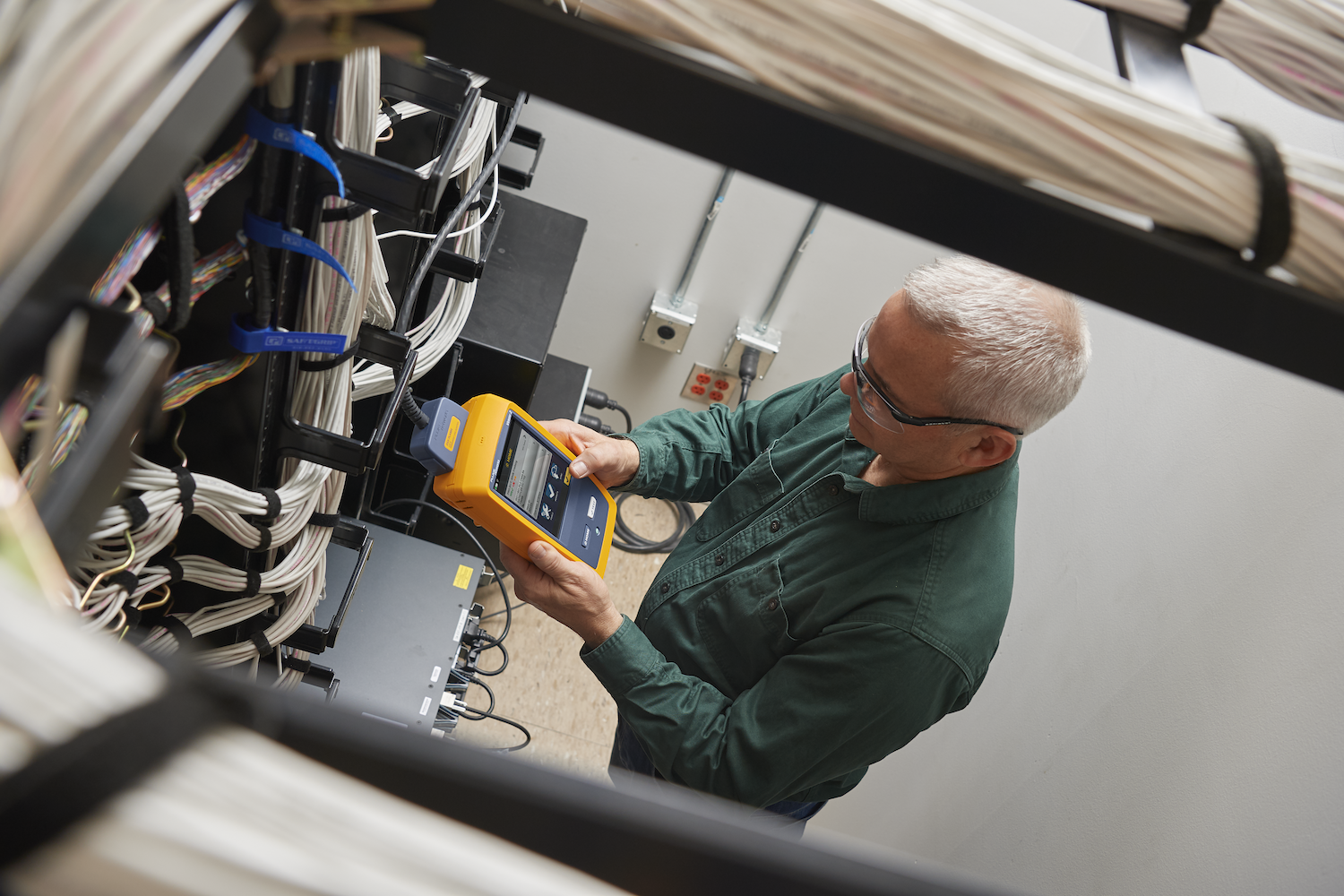
n.° 1: Neglecting to Agree on Test Parameters
When it comes to certifying a copper cabling plant, industry standards such as ANSI/TIA-568.2 and ISO/IEC 11801 specify basic performance parameters, including:
- • Insertion Loss (IL)
- • Return Loss (RL)
- • Near End and Far End Crosstalk (NEXT and FEXT)
- • For Category 6A, Alien Crosstalk testing is also required, since it is a key performance parameter that can impact the ability of 10GBASE-T to operate.
Field testing can include additional optional balance parameters.
- • DC Resistance Unbalance calculates the difference in DC resistance between conductors within a pair and between pairs, indicating support for Power over Ethernet (PoE).
- • Transverse Conversion Loss (TCL) and Equal Level TCL (ELTCTL) measure the common mode signal within a pair, indicating proper balance for noise immunity (including Alien Crosstalk).
The default test limit on a DSX CableAnalyzer™ certification tester is (+PoE), which includes DC Resistance Unbalance. Choosing the (+All) test limit adds TCL and ELTCTL parameters.
Certifying a copper system technically requires testing to the parameters specified by industry standards for the application, including Alien Crosstalk for Category 6A. However, the parameters you ultimately test for are up to your customer's project specification — regardless of what the standards say or what industry experts recommend. If the specification requires a cable plant warranty, you must also test the parameters your cabling manufacturer requires.
You certainly want to avoid the time and expense of retesting parameters you neglected the first time. That's why it's essential to communicate with your customer and cabling manufacturer to agree on all test parameters upfront. It will also help you estimate project costs and prepare you for the job, including making sure your tester can test for every parameter specified, especially newer ones like DC Resistance Unbalance, TCL, and ELTCTL. These parameters can thankfully be tested with a Fluke Networks DSX CableAnalyzer™ certification tester.

Agreeing on testing upfront holds true for fiber testing as well. Ensure that you, your customer, and the cabling manufacturer are all on the same page about performing Tier 1 or Tier 2 fiber testing so you know whether you need an Optical Time Domain Reflectometer (OTDR) in addition to your Optical Loss Test Set (OLTS).
- • Tier 1 testing with an OLTS provides the most accurate insertion loss measurement over the length of a fiber link and is required by industry standards.
- • Tier 2 testing with an OTDR is extended testing that characterizes the insertion loss and reflectance of individual splices and connectors along the fiber link. Note that if you and your customer agree on Tier 2 testing, the use of an OLTS is still required to ensure application compliance, because it accurately measures total insertion loss.
n.°2: Not Agreeing on Marginal Test Results
As an installer, you hope every test for standards-compliant cables will have a pass result. However, everything from installation practices to the quality of the components, and of your tester, can be enough to push a link’s test results into the marginal pass region, where the result is closer to the test limit than the accuracy published by the field tester manufacturer. According to TIA and ISO/IEC standards, any marginal pass is still considered a pass and compliant. The standards also specifically state that marginal test results for a parameter shall be marked with an asterisk (*). This clearly indicates that tester accuracy plays a role.
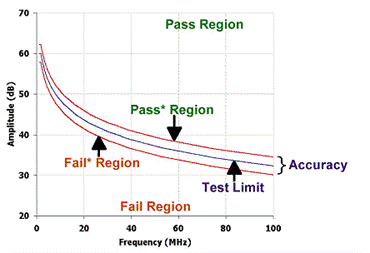
Selecting an industry-compliant tester like the Fluke Networks Versiv™ cable certifier that offers repeatable, exceptional accuracy can minimize marginal test results. Any tester that allows you to disable the asterisk and hide marginal results is non-compliant — not to mention that it can put your reputation and business at risk. Also, ensure that your tester stays in tip-top shape by keeping up with the latest firmware, servicing and calibrating your tester as needed, and making sure your permanent link adapters are not worn out.
Despite all efforts, marginal passes will happen — mainly if the link contains a cross-connect or consolidation point that adds additional connections. Some customers may refuse to accept a marginal pass, wondering what happened to their supposed premium cabling system. That is when you want to make sure you're covered. Remember what the standards say: Unless it was specified and agreed upon in writing that marginal test results are unacceptable, your marginal passes still pass. Agreeing upon marginal test results up front is a smart move.
n.°3: Winging It on Alien Crosstalk Testing
While your customer's project specification and/or manufacturer warranty requirements will determine your test parameters, there's a good chance you will need to perform Alien Crosstalk testing for any Category 6A installation, including PS ANEXT and PS AACR-F. It's the only way to demonstrate compliance for 10GBASE-T applications, and most cabling vendors will not grant a system warranty without it.
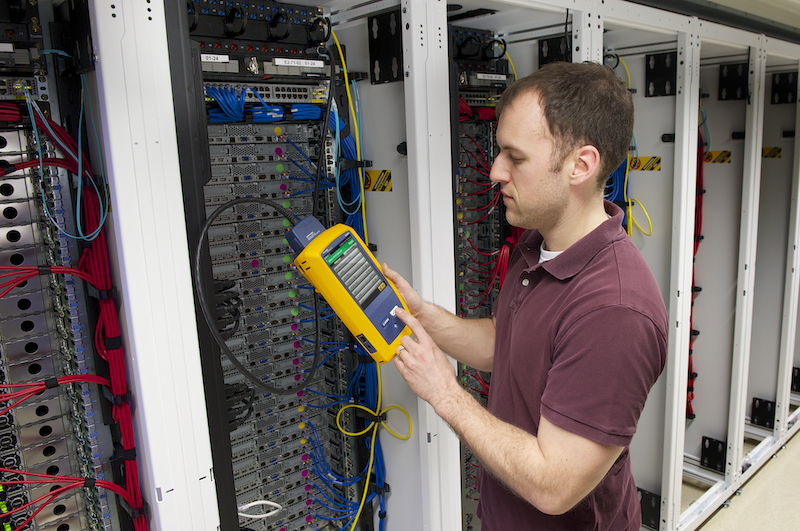
You're only off the hook for Alien Crosstalk testing if it's not specified and the customer and cabling vendor agree not to test for it. While you might think it's not economically feasible or practical to test all links for Alien Crosstalk compliance, don't worry. Industry standards allow you to specify a sample size for Alien Crosstalk testing based on recommendations shown in the table. The standard recommends testing an equal number of short, medium, and long disturbed links. It also states that if three of each of these disturbed links exceed a margin of 5 dB, it's okay to stop testing.
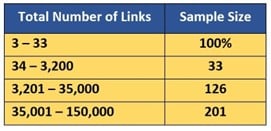
Recommended sample sizes for Alien Crosstalk testing
When choosing disturbed links, do not select those that terminate at the end of a row of connectors — this is not the worst-case scenario. The disturbed link should be surrounded by connectors above and below. However, be sure that the disturbers are in the same bundle; Alien Crosstalk across cable bundles is not considered significant.
Shielded cable offers far superior noise immunity compared to unshielded cable, and it should exhibit hardly any Alien Crosstalk. However, an open shield (not connected) on a shielded cable can result in a failed Alien Crosstalk test. Esto puede ser causado por no instalar el blindaje correctamente, como la fijación con abrazadera en la parte no conductora de la lámina en el cableado. While most testers look for simple continuity between the shield on the main unit and the shield on the remote unit, a signal will look for any way to get to the remote unit — including through the common building ground to which the patch panels and racks are connected. That means the tester will show a connected shield even when it is open. You can avoid this situation with a DSX CableAnalyzer™ certification tester that reports distance to shield integrity issues using a patented measurement technique.
If you still think you can wing it on Alien Crosstalk testing, think again. If it is required by the specification or for a warranty, you must specify a sample size per standards recommendations — whether or not the cabling is shielded. If you don't, you risk having to test every link for Alien Crosstalk, which is a highly costly oversight.
n.°4: Testing the Channel Instead of the Permanent Link
In a network, the channel connects one active device to another, including any patch cords and equipment cords. This could be from an access switch to a server in the data center, including patch cords at cross-connects or interconnects. In the LAN, this could be from an access switch in a telecom room to a laptop, camera, Wi-Fi access point or other device, including the patch cord from the switch to the patch panel and the equipment cord from the outlet to the device. Industry standards limit the overall length of a channel to 100 meters, including up to 90 meters of cabling and no more than 10 meters of patch cords.
The permanent link is the fixed portion of the channel up to 90 meters. It typically consists of cable from a patch panel to another patch panel in the data center, or from a patch panel to a work area outlet or consolidation point in the LAN.

Proper data transmission relies on the channel's performance since it is the complete end-to-end link over which active equipment on the network communicates. It seems intuitive that channel testing would undoubtedly be the way to go, right? Incorrecto.
According to industry standards, using compliant patch cords with a compliant permanent link will always result in a passing channel. However, if you only test the channel using very high-quality patch cords, problems with the permanent link may go undetected, and the channel may not function properly down the road. Once a network is up and running, patch cords are often moved around or replaced in conjunction with equipment reconfigurations. They are also handled and manipulated more than any other component, which makes them more subject to damage. That's why patch cords are often called the "weakest link" in the channel. If you initially test a channel with high-quality patch cords and later on, one of those patch cords gets damaged or replaced with a minimally compliant one, the channel may no longer pass. Therefore, it's essential to test the permanent link — it is the true foundation of the network. You should always end up with a passing channel as long as you add quality standards-compliant patch cords to a passing permanent link.
That’s one of the reasons why the permanent link adapters that come with DSX CableAnalyzer testers are of the highest quality — they avoid adversely impacting the permanent link under test, ultimately ensuring interoperability with compliant patch cords.
n.°5: Testing an MPTL with the Wrong Adapters
A Modular Plug Terminated Link (MPTL) is a direct connection method in which a horizontal cable is terminated on one end to a plug and plugged directly into a device. Industry standards recognize this configuration as an option for connecting devices where it is impractical or unsafe to deploy an outlet and equipment cord. It's also ideal for devices that don't typically need to move, such as PoE lights and surveillance cameras.
With an MTPL plugging directly into a device, you no longer have a typical four-connector channel that you would test as a link with two permanent link adapters. However, you also want to make sure you can verify the performance of the field-terminated plug at the far end. Some technicians have used a channel adapter at the far end, but this excludes the mated connection at the far end from the test, leading to optimistic results and potentially overlooking problems with the field-terminated plug. Your risk is a non-functioning link once the cable is plugged into a device.
Instead, industry standards require a permanent link adapter at the near end and a patch cord adapter at the far end, as shown in the graphic. This will guarantee that the performance of the field-terminated plug is included in your results. Fluke Networks provides a single patch cord adapter with the DSX CableAnalyzer permanent link adapter to make it easy. Just make sure to select MPTL under the test limits on your tester.
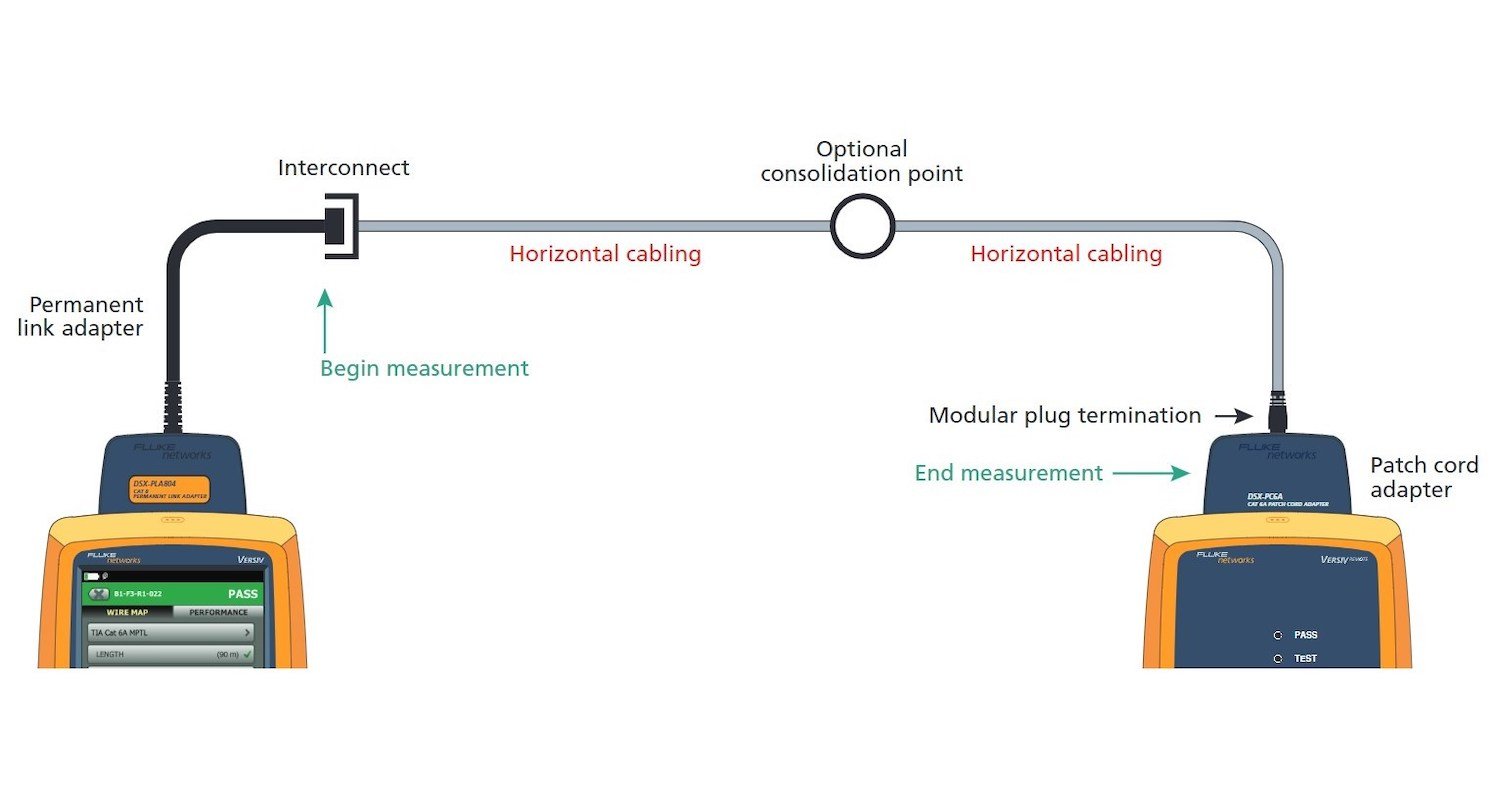
n.°6: Forgetting to Enable Plot Data for Your Test Results
Plot data is the full-color graphical depiction of measured test parameters required for certification testing. For copper certification, plot data includes graphs for key parameters, including Insertion Loss (IL), Return Loss (RL), Near End and Far End Crosstalk (NEXT, PSNEXT, PSACRN, ACRF, PSACRF), and Alien Crosstalk (PS ANEXT and PS AACR-F). Each graph shows decibels (dB) on the Y axis and frequency on the X axis. The frequency will vary depending on the type of cabling being tested: up to 100 MHz for Category 5e, 250 MHz for Category 6, and 500 MHz for Category 6A. Note that you can also extend the frequency, which can be handy for recertifying a cable to a higher standard.
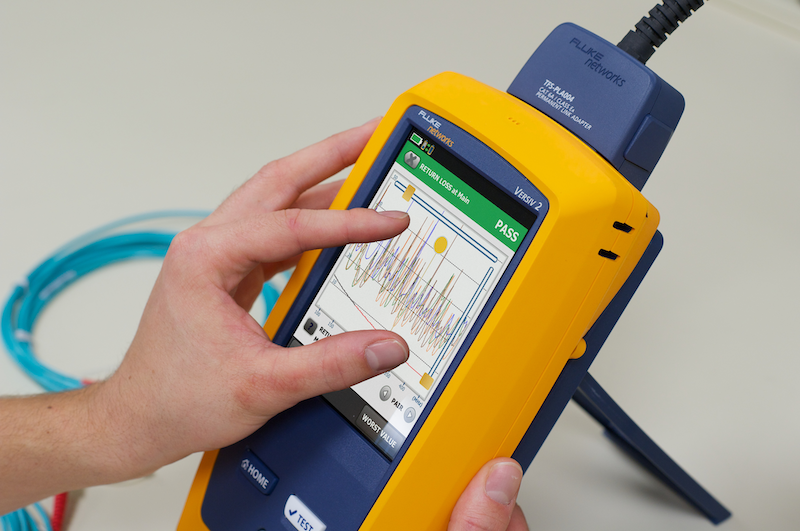
For each graph, the smooth red line shows the testing limits of the standard you're testing to (i.e., TIA, ISO/IEC, etc.). Las líneas irregulares de color muestran los resultados de pares individuales y pares de combinaciones. Estas líneas son irregulares ya que los resultados reales suelen tener picos y valles, lo que no es un problema siempre y cuando se mantengan por encima del límite.

It is essential to enable plot data, because it is typically required for certification testing and shows valuable visual information about the performance of individual pairs within the cable. It is also the only way to truly diagnose what might be causing an issue with your link under test, since you can see where the crosstalk is happening. You must also enable plot data with your DSX CableAnalyzer tester to include HDTDX (High Definition Time Domain Crosstalk) and HDTDR (High Definition Time Domain Reflectometry) parameters that show time domain information for indicating the location on the link under test where crosstalk or return loss is excessive.
Plot data is also essential if you need Fluke Networks troubleshooting support. If you don't have plot data available for our technical experts to analyze, we will ask you to retest with plot data enabled, doubling your test time. Thankfully, the default setting for the DSX CableAnalyzer certification tester is to display and save plot data for frequency-based tests required by the selected test limit. Como mínimo, se recomienda mantenerlo de esa manera. Choosing "extended" will save data beyond the frequency range of the selected test limit. Besides, your customer will appreciate a headroom visual — reports without plot data will look empty.
n.°7: Skipping Proper Fiber Inspection and Cleaning
Despite constant reminders and education surrounding the importance of inspecting fiber end faces, contaminated connections remain the number one cause of fiber network problems and failures. Whether at a fiber cross-connect, equipment port, or the end of a jumper, wherever there is an exposed fiber end face, you risk contamination and ending up with particles on the fiber core that can cause loss and reflections. Skipping or simply forgetting to properly inspect and clean fiber before making that final connection can be the difference between moving on to your next job with a satisfied customer and spending the extra time (and money) troubleshooting a problem.
When inspecting fiber end faces, you cannot get away with just a quick manual inspection using a fiber microscope. Your experience level, ambient lighting, eyesight, and even how rushed or tired you are can impact your ability to inspect a fiber end face accurately.
The good news is that there is a fiber inspection standard to help streamline the process and remove any human subjectivity. The IEC 61300-3-35 Basic Test and Measurement Procedures Standard for Fiber Optic Interconnecting Devices and Passive Components provides a recommended cleaning and inspection process that includes specific cleanliness grading criteria based on the number and size of scratches and defects found in the critical core and cladding areas of a fiber end face. Following this standard can help avoid unnecessary and costly cable and/or equipment replacement.

Even better news is that Fluke Networks fiber inspection tools provide an automated PASS/FAIL based on the IEC 61300-3-35 standard.
n.°8: Not Using the One-Jumper Reference for Tier 1 Fiber Testing
For Tier 1 fiber testing, connector loss refers to the loss of a mated pair of connectors. It is essentially impossible to measure the loss of a single connector. Testing a permanent fiber link, such as from one patch panel to another, should include the loss of both the first and last connectors, since that is how the cabling plant will be used. To measure the loss of these connectors, they must be mated to a connector of similar quality using test reference cords (TRCs).
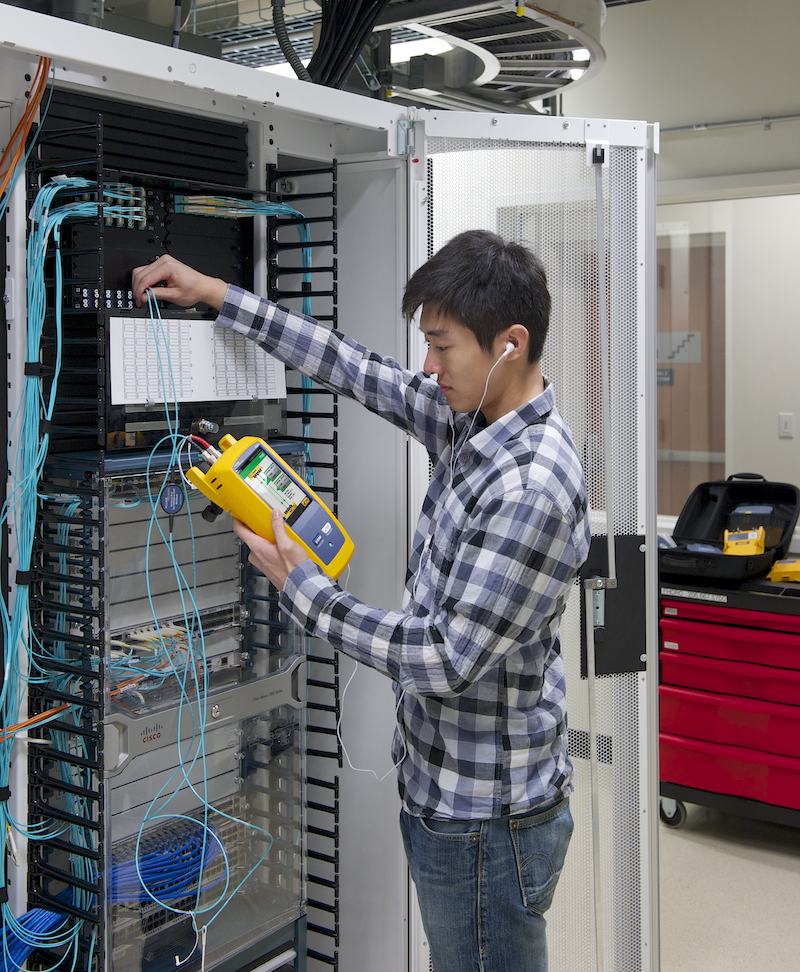
When using a TRC, the tester must consider the TRC's loss by setting a reference, which is like placing a bowl on a scale and then calibrating the scale to zero to accurately weigh whatever you put in the bowl. Industry standards recommend using the one-jumper reference method to set a reference. This allows the test to include the loss of the connections at both ends of the channel. Dado que la mayor parte de la pérdida de un canal es causada por estas conexiones, el método de referencia de un cable ofrece la precisión más alta.
While a two-jumper reference might seem to make more sense, this references out the connection between the two jumpers and ultimately includes only one end connection in the loss measurement. It only partially depicts the total loss and can lead to overly optimistic or even negative loss results. Such a negative loss caused by a two-cord reference will result in a warning and a FAIL on the Fluke Networks CertiFiber Pro® Optical Loss Test Set. Many cabling vendors will reject any results carried out with a two-cord reference, which could prevent you from acquiring a warranty.
When setting the reference, the CertiFiber Pro tester offers a Set Reference Wizard that takes you through the process step by step using animation. It shows you exactly how to connect your TRCs to your main and remote units. Once the reference is set, the Wizard will walk you through disconnecting the TRCs from the input ports.
n.°9: Using the Wrong Reference Cord for Fiber Testing
When certifying a fiber cable plant, use only TRCs recommended by your test equipment manufacturer. True TRCs, like those offered by Fluke Networks, are constructed of reference-grade cable and connectors with a very low loss of better than 0.1dB for multimode and 0.2dB for single-mode. Anything other than a true TRC could lead to false failures — the impact on your bottom line can cost you far more than anything you saved by purchasing a cheap substitute. Imagine having to reinstall a fiber link that would have passed if you had used the recommended TRCs in the first place.
Regardless of which TRCs you use, it is best practice to verify the performance of your TRCs before you begin testing. It tells you that when a link fails, it was not caused by poor TRCs. We recommend verifying your TRCs every 288 tests and documenting those results, so you have a benchmark to determine if your TRCs are worn out and need replacing. The CertiFiber Pro tester wizard steps you through the process of verifying your TRCs.
It is also essential to use the correct type of TRC. For multimode fiber, industry standards require encircled flux (EF) testing that more closely matches the launch conditions of today's optical fiber transceivers. EF testing reduces measurement uncertainty, prevents overly optimistic results, and is required by cabling vendors to acquire a warranty. When testing multimode, you need an EF-compliant tester, like the CertiFiber Pro OLTS, along with EF-compliant TRCs.
Although EF testing is standards compliant and the best practice, if you still use a common mandrel to control launch conditions and improve accuracy by removing higher-order modes, pay close attention to your TRCs. If you cut corners and use typical cords, they could be constructed from bend-insensitive multimode fiber (BIMMF). Since BIMMF withstands tighter bends with substantially less signal loss, using BIMMF test cords in conjunction with a mandrel does not strip out the higher-order modes. In fact, industry standards state that non-BIMMF should be used in all test cords — even if the link you're testing uses BIMMF. EF testing with our EF non-BIMMF TRCs is a far more accurate method of testing multimode fiber, which is why industry standards require it.
n.°10: Relying on a Duplex Tester for MPO Cable Certification
Most high-speed 100 to 800 Gigabit fiber links in the data center rely on multi-fiber push-on (MPO) connector solutions. Las pruebas de campo son la única forma de asegurarse de que los enlaces de MPO cumplan con los requisitos del rendimiento de aplicaciones. It seems only logical that testing a multi-fiber MPO fiber link with a duplex tester would be time-consuming. In fact, testing a link terminated to 12-fiber MPO connectors with a duplex tester requires about 15 steps with a three-jumper method and the use of MPO to LC fan-out cords or low-loss MPO to LC cassettes that separate the 12-fiber cable into single fiber channels.
To test MPOs with a duplex tester, you must first verify and set the SC-LC and LC-LC test reference cords. A third LC test reference cord then needs to be verified, set, and removed before even connecting to the first pair of fibers on the MPOs — and there are five more pairs to test on both ends. This complex, time-consuming process has the inherent potential for greater inconsistencies and makes it more challenging to keep all the connectors clean during the process.

Testers with an on-board MPO connector take the complexity, time, and inconsistency out of MPO testing, eliminating the need for the fan-out cord or cassette. The Fluke Networks MultiFiber™ Pro Optical Power Meter offers this functionality, allowing for simultaneous scanning of all fibers and displaying test results in an easy-to-read bar graph. The MultiFiber Pro tester can identify each fiber of the MPO, providing more precise per-fiber data and reporting to improve MPO connector verification and troubleshooting. It can even test for correct polarity, which ensures a continuous connection from the transmitter to the receiver. The MultiFiber Pro tester allows you to test individual patch cords, permanent links, and channels for correct polarity without prior knowledge of the link's polarity.
The next time you think a duplex tester will suffice for your MPO testing, remember that a tester with an on-board MPO interface like MultiFiber Pro will eliminate the complexity and allow you to test 90% faster.




